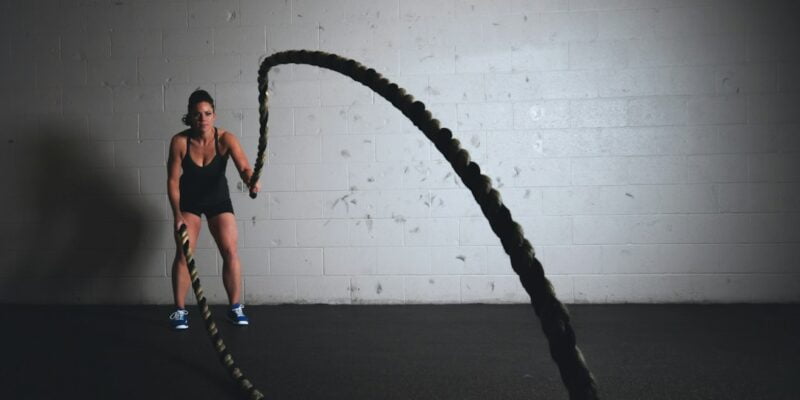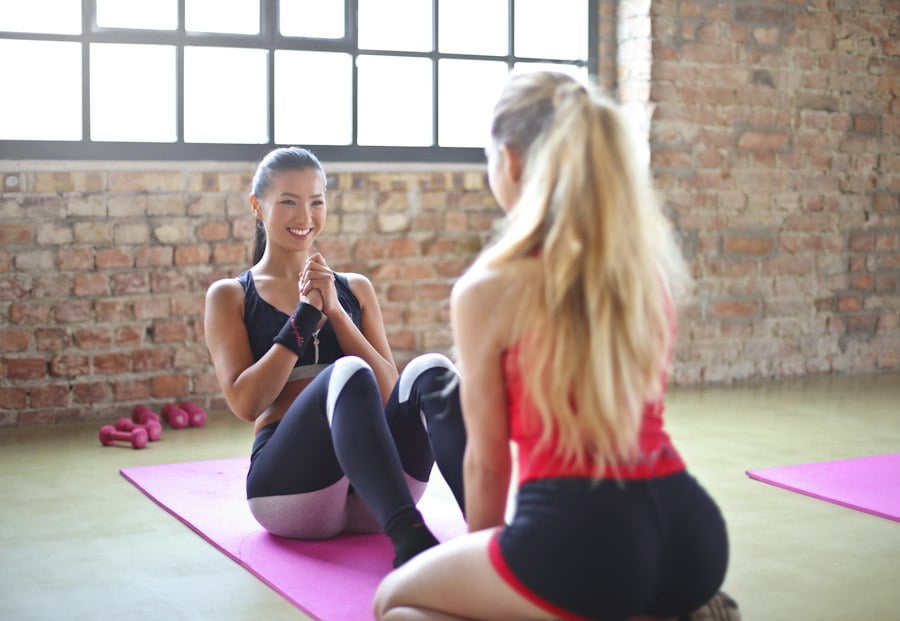
The Good Morning Exercise: A Must-Have in Your Workout Routine for Maximum Benefits
The Good Morning exercise is a compound movement that primarily targets the posterior chain muscles, including the hamstrings, glutes, and lower back. It is performed by bending forward at the hips while keeping the back straight, mimicking the motion of bowing. This exercise is often overlooked but is an important addition to any workout routine due to its numerous benefits.
Including the Good Morning exercise in your workout routine can help improve your posture, increase strength, and reduce the risk of injury. It is a functional movement that mimics everyday activities such as bending over to pick up objects or tying your shoes. By strengthening the muscles involved in these movements, you can improve your overall functionality and reduce the risk of strains or injuries.
Key Takeaways
- The Good Morning Exercise is a compound exercise that targets multiple muscle groups in the body.
- Benefits of the Good Morning Exercise include improved posture, increased strength and flexibility, and reduced risk of injury.
- Muscles targeted by the Good Morning Exercise include the hamstrings, glutes, lower back, and core.
- To perform the Good Morning Exercise correctly, keep your back straight, hinge at the hips, and engage your core.
- Common mistakes to avoid while doing the Good Morning Exercise include rounding your back, lifting too much weight, and not warming up properly.
Benefits of the Good Morning Exercise
The Good Morning exercise offers a wide range of benefits for individuals of all fitness levels. One of the key benefits is improved posture. By strengthening the muscles in your lower back and core, you can maintain a more upright posture throughout the day. This can help alleviate back pain and prevent slouching or hunching over.
Additionally, the Good Morning exercise helps increase strength in the posterior chain muscles. The hamstrings, glutes, and lower back are all heavily involved in this movement, making it an effective way to target these muscle groups. By increasing strength in these areas, you can improve your performance in other exercises such as squats and deadlifts.
Scientific evidence supports these benefits of the Good Morning exercise. A study published in the Journal of Strength and Conditioning Research found that participants who performed the exercise twice a week for eight weeks experienced significant improvements in their hamstring strength and flexibility. Another study published in the Journal of Sports Science and Medicine found that individuals who incorporated the Good Morning exercise into their training program had reduced lower back pain and improved functional movement.
Muscles Targeted by the Good Morning Exercise
The Good Morning exercise primarily targets the hamstrings, glutes, and lower back muscles. These muscles play a crucial role in maintaining proper posture, stability, and overall strength.
The hamstrings are a group of muscles located at the back of the thigh. They are responsible for flexing the knee and extending the hip. When performing the Good Morning exercise, the hamstrings are engaged as you bend forward at the hips and then return to an upright position.
The glutes, or buttock muscles, are also heavily targeted during the Good Morning exercise. They are responsible for hip extension and play a key role in stabilizing the pelvis and lower back. By strengthening the glutes, you can improve your overall lower body strength and stability.
The lower back muscles, including the erector spinae and multifidus, are also engaged during the Good Morning exercise. These muscles help maintain proper spinal alignment and provide support to the spine. Strengthening these muscles can help alleviate lower back pain and improve overall spinal stability.
How to Perform the Good Morning Exercise Correctly
| Exercise Name | Good Morning |
|---|---|
| Primary Muscles Worked | Erector Spinae, Glutes, Hamstrings |
| Equipment Needed | Barbell, Weight Plates, Squat Rack |
| Difficulty Level | Intermediate |
| Benefits | Improves Posture, Increases Lower Back and Hamstring Strength, Enhances Hip Mobility |
| Instructions | 1. Stand with feet shoulder-width apart and barbell resting on your upper back. 2. Hinge at the hips and lower your torso until it’s parallel to the floor. 3. Keep your back straight and core engaged. 4. Return to starting position by contracting your glutes and hamstrings. 5. Repeat for desired number of reps. |
To perform the Good Morning exercise correctly, follow these step-by-step instructions:
1. Start by standing with your feet shoulder-width apart and your toes pointing forward.
2. Place your hands on your hips or cross them in front of your chest.
3. Engage your core and keep your back straight throughout the movement.
4. Slowly bend forward at the hips while keeping your knees slightly bent.
5. Lower your upper body until it is parallel to the floor or until you feel a stretch in your hamstrings.
6. Pause for a moment at the bottom of the movement.
7. Engage your glutes and hamstrings to return to an upright position.
8. Repeat for the desired number of repetitions.
It is important to maintain proper form while performing the Good Morning exercise to avoid injury. Keep your back straight and avoid rounding or arching your spine. Additionally, make sure to engage your core and glutes throughout the movement to maximize the benefits.
Common Mistakes to Avoid While Doing the Good Morning Exercise
While the Good Morning exercise is highly beneficial, there are some common mistakes that people make while performing it. These mistakes can not only reduce the effectiveness of the exercise but also increase the risk of injury.
One common mistake is rounding the back during the movement. This can put excessive stress on the spine and increase the risk of lower back injuries. To avoid this, focus on keeping your back straight and maintaining a neutral spine throughout the exercise.
Another mistake is using too much weight or overloading the barbell. This can lead to poor form and increase the risk of strain or injury. It is important to start with lighter weights and gradually increase the load as you become more comfortable with the exercise.
Lastly, rushing through the movement is another common mistake. It is important to perform the Good Morning exercise in a slow and controlled manner to maximize its benefits. Take your time and focus on engaging the targeted muscles throughout the entire range of motion.
Variations of the Good Morning Exercise

There are several variations of the Good Morning exercise that can be incorporated into your workout routine to increase its difficulty and target different muscle groups.
One variation is the Barbell Good Morning, which involves performing the exercise with a barbell placed across your upper back. This variation adds resistance and increases the challenge for your posterior chain muscles.
Another variation is the Single-Leg Good Morning, which involves performing the exercise while balancing on one leg. This variation increases stability and engages additional muscles in your core and hips.
You can also add weights or resistance bands to increase the difficulty of the exercise. Holding dumbbells or wearing ankle weights can provide additional resistance and help you progress in your strength training journey.
Incorporating the Good Morning Exercise in Your Workout Routine
To incorporate the Good Morning exercise into your workout routine, consider the following tips:
1. Start with bodyweight or light weights if you are a beginner. Focus on mastering the form and gradually increase the load as you become more comfortable with the exercise.
2. Include the Good Morning exercise as part of your lower body or full-body workout routine. It can be performed on its own or as a part of a circuit.
3. Aim to perform the exercise 2-3 times per week for optimal results. This frequency allows for adequate recovery and muscle growth.
4. Warm up properly before performing the Good Morning exercise to prepare your muscles and joints for the movement. Dynamic stretches and mobility exercises can help improve flexibility and reduce the risk of injury.
Frequency and Repetitions for the Good Morning Exercise
The frequency and repetitions for the Good Morning exercise can vary depending on your fitness level and goals.
For beginners, it is recommended to start with 2-3 sets of 8-10 repetitions. Focus on maintaining proper form and gradually increase the load as you become more comfortable with the exercise.
For advanced exercisers, you can increase the number of sets and repetitions to challenge your muscles further. Aim for 3-4 sets of 10-12 repetitions with heavier weights.
It is important to listen to your body and adjust the frequency and repetitions based on your individual needs and recovery abilities.
Safety Precautions to Take While Doing the Good Morning Exercise
To ensure safety while performing the Good Morning exercise, consider the following precautions:
1. Start with lighter weights or bodyweight if you are a beginner. Focus on mastering the form before adding additional resistance.
2. Avoid rounding or arching your back during the movement. Keep your back straight and maintain a neutral spine throughout.
3. Engage your core and glutes throughout the exercise to provide stability and support to your spine.
4. Do not overload the barbell or use excessive weight. Gradually increase the load as you become more comfortable with the exercise.
5. If you have any pre-existing injuries or conditions, consult with a healthcare professional before attempting the Good Morning exercise.
Taking these safety precautions will help reduce the risk of injury and ensure that you can perform the exercise safely and effectively.
Why the Good Morning Exercise Should Be a Part of Your Workout Routine
The Good Morning exercise is a highly beneficial compound movement that targets the posterior chain muscles and offers numerous benefits. By including this exercise in your workout routine, you can improve your posture, increase strength, and reduce the risk of injury.
Remember to start with lighter weights or bodyweight if you are a beginner and gradually increase the load as you become more comfortable with the exercise. Focus on maintaining proper form and engaging the targeted muscles throughout the movement.
If you are unsure about how to perform the Good Morning exercise correctly or have any concerns, consult with a qualified fitness professional who can provide guidance and ensure that you are performing the exercise safely and effectively.
Incorporating the Good Morning exercise into your workout routine can help take your fitness journey to the next level and improve your overall strength and functionality. Give it a try and experience the benefits for yourself!
FAQs
What are good mornings?
Good mornings are a weightlifting exercise that targets the lower back, glutes, and hamstrings. It involves bending forward at the hips while holding a barbell across the shoulders.
What are the benefits of doing good mornings?
Good mornings can help improve posture, increase lower back and hamstring strength, and enhance overall athletic performance. They can also help prevent lower back injuries and improve flexibility.
How do I perform good mornings correctly?
To perform good mornings, start by standing with your feet shoulder-width apart and the barbell resting across your shoulders. Slowly bend forward at the hips, keeping your back straight and your knees slightly bent. Lower the barbell until your torso is parallel to the ground, then slowly return to the starting position.
Are there any risks associated with doing good mornings?
Like any weightlifting exercise, there is a risk of injury if good mornings are not performed correctly. It is important to start with a light weight and gradually increase the weight as you become more comfortable with the exercise. It is also important to maintain proper form throughout the exercise to avoid injury.
Can good mornings be done by beginners?
Good mornings can be done by beginners, but it is important to start with a light weight and focus on proper form. It is also recommended to work with a trainer or experienced weightlifter to ensure proper technique and avoid injury.


















